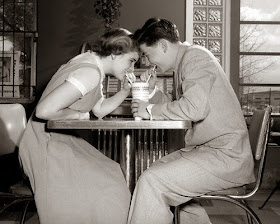Day 3/Step 3/Week 3 of the Miracle 7 Day Glamour Course covers "how to plan your wardrobe" and starts with cleaning out your closet. Hope you had a good breakfast. Then, as now, closet cleaning is a strenuous activity, and the Course warns be prepared—it could take all day.
If you've ever read anything about cleaning closets you will recognize the info: Take everything out, try it all on and (in this suggestion) end up with two piles—things you love and things you will give away. "Your room will be a mess in no time, but it's in a good cause."
> Test for your life
Does it fit into your life or is there not a chance you will really wear it? I think we keep a lot of things hanging there for sentimental reasons (though this isn't mentioned). If you are "never going to wear a blush pink velvet hostess gown", chuck it.
> Test for your looks
Try every piece on and check every point in the mirror. If it flatters, okay. Otherwise, out.
> Check the shape that it's in
This is good advice as too often we neglect to notice pilling, worn or threadbare spots, loose hems, etc. If it can be mended or fixed, okay. Otherwise, out. Don't put anything that needs work back in the closet. If you're a procrastinator and know you'll never take care of it, better to let it go.
> Make a list
This might be more than you care to start. It would probably have been a lot shorter in 1952 when no one had so many clothes as we do now. Remember those headings: city, casual, date and home clothes? List what goes under which and how many "costumes" you need (yes they call it that) to complete the group The former owner of this magazine attempted to fill in her list but gave up after one entry.
> Add accessories
Line up all your accessories—hats, gloves, shoes, jewelry, scarves. Go over each piece carefully, determine what you need to complete those outfits, add them to the list, and discard the rest.
You will notice nothing is given the chance to "mix and match". Everything needed to be an outfit, complete with particular accessories to finish the look. No one yet thought of basic pieces that could cover many occasions or that were de rigueur to have.
The next 8 pages give examples of city, casual, date and home clothes. Not a pair of pants among them.
We can be grateful no one needs that city look anymore. A pea coat, sweater, skirt and hoop earrings are timeless. Minus the cigarette, you could still wear the date look. The special dress to wear at home after work never did catch on. It's still a good idea to change your clothes, if only to cut down on laundry and dry cleaning.
 |
| City |
 |
| Casual |
| Date |
 |
| Home |
Can we go shopping? Not yet. You must make another list, this one to determine if you have at least one outfit in every category. We are told it's better to have one or two outfits in each and repeat them rather than have the full component in city looks but nothing to wear on a date.
Throughout the Course those dates hang over us like ice cream sundaes. One surmises women lived for date night.
The next chapter is called "What are you going to use for money?" I can hardly wait.



































